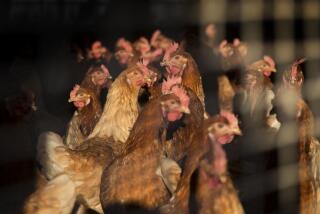Foster Farms says it has reduced salmonella rates in chicken
They found no smoking gun — no well or pasture or single source of contamination for the ongoing salmonella outbreak at Foster Farms.
But on Monday, executives at the California chicken company announced that they had reduced levels of contamination in raw, cut-up chicken to well below the industry average.
Foster Farms salmonella rates are now about 2% compared with the national average of 25%, said Bob O’Connor, one of the company’s two full-time veterinarians and a senior vice president.
The reduction is “due to a lot of trial and error and waiting for modifications to kick in,” O’Connor said, adding that salmonella remains a concern.
“For the people who wanted a silver-bullet-type story, there isn’t one. With salmonella we’re not going to be able to say ‘It’s over.’ It’s an ongoing effort.”
Chris Braden, a director with the U.S. Centers for Disease Control and Prevention, said he was hopeful that the ongoing breakout is coming to an end.
“I’m impressed with many of the things they’ve done,” he said. “But we’re still seeing a higher number of illnesses. So the investigation continues until we know for sure whether they are coming from Foster Farms or another source. We are going to be very vigilant.”
Usually six to eight people report a virulent form of salmonella during the summer, Braden said. The numbers are still at about 10 per week.
Monday’s announcement, made during Foster Farms’ 75th anniversary celebration, was the company’s first public statement since October, when the federal government threatened to close plants in the Central Valley, where unemployment rates hover near 20%.
The company said it has undertaken a multi-step program to battle the outbreak.
Foster Farms is vaccinating birds five times, chlorinating water, using acid litter and probiotic feed. Workers have bio-mapped company facilities, zeroing on the hot spots.
On Monday, O’Connor led a tour of a chicken ranch that had shown one of the highest levels of contamination. The long, low building was filled with lively, fluffy chicks. The birds arrive freshly hatched, eggshells sometimes clinging to them. They are kept in the controlled environment for 45 days. At the end of that time they weigh 5 pounds and are sent for processing.
O’Connor said the walls had been washed and sanitized, all the rice hulls on the floor removed and the ground swept like a barn. After cleaning, the space had been left fallow for two months, before the next flock.
He said the company also added more controls at every other level of the process, including testing for salmonella after carcasses have been divided into parts. This gives immediate feedback on any increase in contamination.
Salmonella is a form of bacterium found in most chickens. It does not sicken the bird, but some forms can cause illness and death in humans.
“It’s just a nightmare trying to figure out how a breakout of salmonella gets into a chicken plant. There are so many possibilities going back to the hens,” said Thomas Elam, an Indiana farming consultant. “But assuming their data is correct, Foster Farms now has one of the lowest rates in the country.”
In a home setting, virulent salmonella is equally contagious and hard to trace. It can live in cracks in cutting boards or linger in a sink, contaminating utensils or already cooked chicken, even making someone ill from direct contact.
More than 750 people have been sickened by two outbreaks linked to Foster Farms since 2012. More than three-quarters of those affected were in California.
The latest outbreak, which began in March 2013, is ongoing and has sickened 50 people in the last two months, according to the CDC.
Outbreaks are a growing concern for the industry, partly because strains are becoming increasingly resistant to antibiotics.
The most recent strain, known as Salmonella Heidelberg, has proved especially virulent and resistant to some antibiotics. About 40% of the affected consumers have been hospitalized, double the usual rate, according to the CDC.
The U.S. Department of Agriculture did not issue a health alert for the current outbreak until October 2013. Even as national retail chains such as Kroger Co. pulled Foster Farms products from their meat cases, the 75-year-old poultry firm did not issue a recall. Instead, it relayed the recommendations of federal inspectors, which was to cook all chicken to a minimum of 165 degrees.
Foster Farms issued a public apology, overhauled some of its safety practices and vowed to win back consumers’ trust. But in another setback, the firm closed its flagship factory in Livingston, Calif., for 10 days in January because of a cockroach infestation.
The outbreak sparked calls from food safety and consumer advocates for federal laws to treat salmonella as strictly as other food-borne illnesses such as E. coli, which triggers an automatic recall.
Company executives said that Foster Farms sales dipped during the first news of the outbreak that made so many people ill but that sales have since recovered.
Twitter: @dianamarcum
Times staff writer David Pierson contributed to this report.







